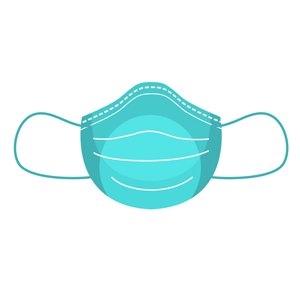
Efficacy of Face Masks, Respirators and Face Coverings
July 23, 2020
Article written by Janelle Bentz, Nelson Labs
What is the difference between a medical face mask and respirator, and how and when they should be used? The quick answer is medical face masks are meant to protect others and your environment; respirators are meant to protect the wearer.
A medical face mask helps reduce contamination from the wearers’ nose and mouth (saliva and respiratory secretions, as well as droplets generated by a cough or a sneeze) getting on others or entering the environment. Although protecting others and the environment is the main intent of the masks, they can also reduce the likelihood of the larger particle droplets, splashes, sprays, or splatter that may contain potentially infectious diseases from reaching the wearer’s nose and mouth. However, medical face masks, by design do not filter or block very small particles in the air and do not provide total protection from aerosolized droplets which may contain pathogens.
Respirators, on the other hand, fit tightly and are used to protect the wearer from breathing in small particles. NIOSH-approved N95 respirators are respiratory protective devices designed to achieve a very close facial fit, very efficient filtration of small airborne particles, and can block at least 95% of tiny (0.3 micron) particles. It is important to note that while a respirator may be properly fitted and filtering as promised, this does not eliminate the risk of infection from an airborne pathogen—only 95% of the pathogens are blocked. For better protection, N99 and N100 respirators are available, which filter out 99% or 99.97% of the particles in the testing.
Required testing for medical face masks evaluates the performance of the mask in containing larger aerosol droplets, and how well they protect the wearer from splashes. Medical face masks are effective when worn by sick persons to keep from spreading infectious disease or by healthcare workers to reduce contamination of sterile working fields. For medical face masks, the U.S., Europe, and Australia require Bacterial Filtration Efficiency (BFE) testing. During this type of testing, the mask is subjected to a high number of aerosol droplets containing Staphylococcus aureus. During a 1-minute test, at a flow rate of 28.3 L/min, the mask is required to filter at least 95% to 98% of those droplets to qualify for a barrier level under the U.S. (ASTM F2100) and European (EN 14683) standards.
For respirators, the U.S. requires the Sodium Chloride (NaCl) filtration efficiency test on a TSI 8130 tester for N95, N99, and N100 NIOSH certification. The mask is subjected to a high number of aerosol droplets containing Sodium Chloride for a duration that produces the maximum penetration at a flow rate of 85 L/min. The mask is required to filter 95% or more of those droplets to qualify for a NIOSH N95 certification.
NIOSH testing is considered “worst-case” as the testing conditions are the most severe likely to be encountered in a work environment, and additional fit testing must be passed for certification by NIOSH. The testing required for NIOSH rated respirators (such as N95) evaluates the performance of the mask to keep out small, penetrating airborne droplets. Respirators are effective to protect the wearer from airborne particles in the environment but only when fit properly. Although respirators undergo fit testing, the person wearing the respirator should pay attention to the proper fitting of their respirator.
Cloth face coverings allow a certain level of protection by reducing the larger, potentially infectious particles generated from coughs or sneezes from being spread to other people. However, their efficacy varies widely depending on the material used and how snugly they fit. As blocking the spread of as many airborne particles as possible is the ultimate goal, wearing these types of face coverings is much better than not wearing any face mask at all.